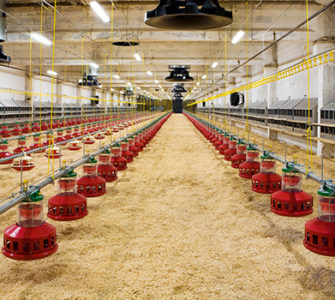Necrotic enteritis control requires multi-pronged approach in RWA systems
Feeding higher levels of copper and zinc in the diet, managing litter moisture and controlling coccidiosis are keys to stopping necrotic enteritis (NE) in poultry raised without antibiotics (RWA), Dan Moore, PhD, president, Colorado Quality Research, told Poultry Health Today.
“We’re seeing a very consistent result with copper,” Moore said. Instead of the typical 8 to 10 parts per million inclusion level in the diet, they have used 250 to 275 parts per million in some studies.
The combination of copper and zinc in the feed, long used in the swine industry, has also yielded encouraging results in poultry for reducing the incidence of NE, he reported.
“We’ve had minerals in the diet for decades, but we’ve used them at fairly low levels, partially because of the form utilized,” Moore added. “Now, with some of the new forms that are coming out and being studied more directly, we can use higher levels and are starting to see some of that difference.”
Feed management
There is an increased interest in how the bird’s gut microflora is changing as the transition is made to production without the use of antibiotics, Moore said.
Changes in the feed form or type can make birds more susceptible to NE, so those adjustments must be introduced slowly. Make sure there’s no feed shortages, because the birds can then gorge themselves once feed is available again, which can cause problems, he explained.
Moore emphasized it’s important to understand the different levels of feed ingredients needed and cautioned against overfeeding.
Keep litter dry
Keeping litter dry also helps to prevent coccidiosis — a disease
that damages the gut and leads to proliferation of Clostridium, the bacterium that causes NE. Maintaining good litter quality depends on proper management, including the use of litter amendments, Moore noted.
An interesting finding, he added, is that birds are more likely to develop NE on new versus used litter. It appears that chicks placed on used litter develop some immunity to Clostridium, while chicks on clean litter don’t and are more susceptible to infection.
Research matters
Over the past 3 years, Colorado Quality Research has run 124 comparisons evaluating antibiotic alternatives to reduce NE. The research models used attempt to duplicate the environmental conditions of a commercial chicken house.
Antibiotic alternatives can help reduce mortality and gut lesions and improve performance, but the results are not as good as they are with antibiotics, he noted.
Nevertheless, because mortality, gut lesions and performance are top priorities for poultry producers with RWA systems, finding alternatives to antibiotics is important. The research so far indicates that a multi-faceted approach is needed, Moore said.
Posted on October 17, 2019

















